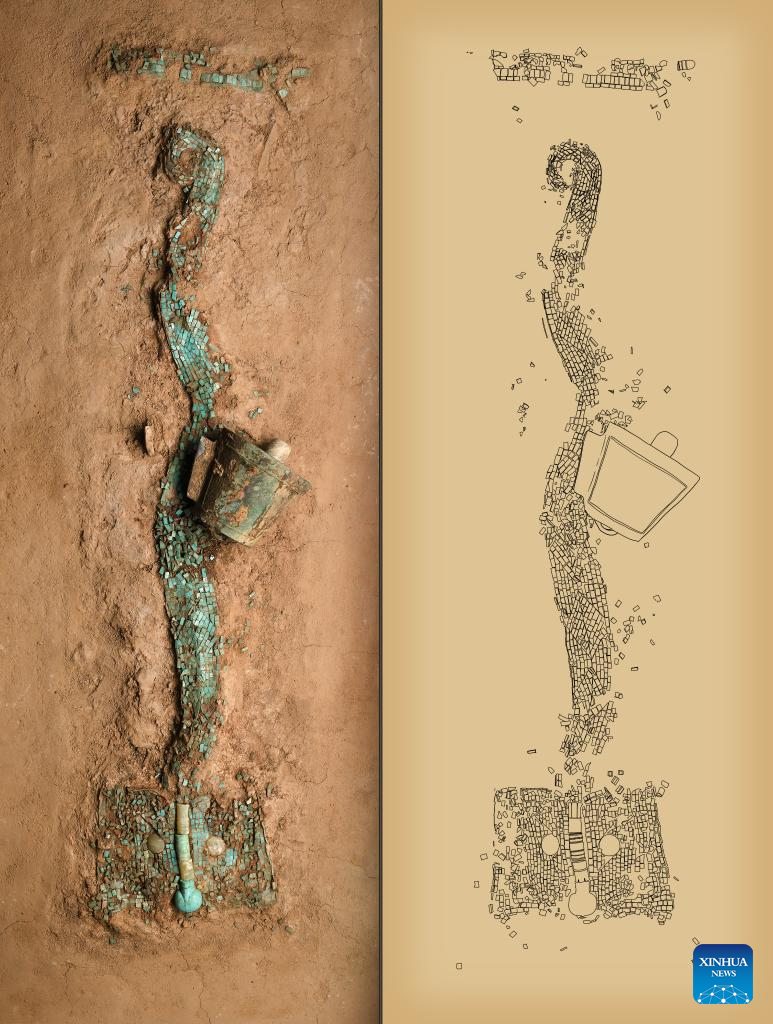
This combo image shows a turquoise dragon-form artifact at Chinese Archaeological Museum in Beijing, capital of China, Jan. 29, 2024 (L, photo taken by Xinhua photographer Li He), and an outline of the artifact drawn by Zhou Qi. Unearthed from Erlitou site in the city of Luoyang, the turquoise dragon-form artifact has a total length over 70 centimeters and was formed from more than 2,000 pieces of turquoise. Chinese archaeologists dubbed the artifact the "Dragon of China", which has great historical, artistic and scientific value. (Xinhua)

This photo taken on Jan. 29, 2024 shows a turquoise dragon-form artifact at Chinese Archaeological Museum in Beijing, capital of China. Unearthed from Erlitou site in the city of Luoyang, the turquoise dragon-form artifact has a total length over 70 centimeters and was formed from more than 2,000 pieces of turquoise. Chinese archaeologists dubbed the artifact the "Dragon of China", which has great historical, artistic and scientific value. (Xinhua/Li He)
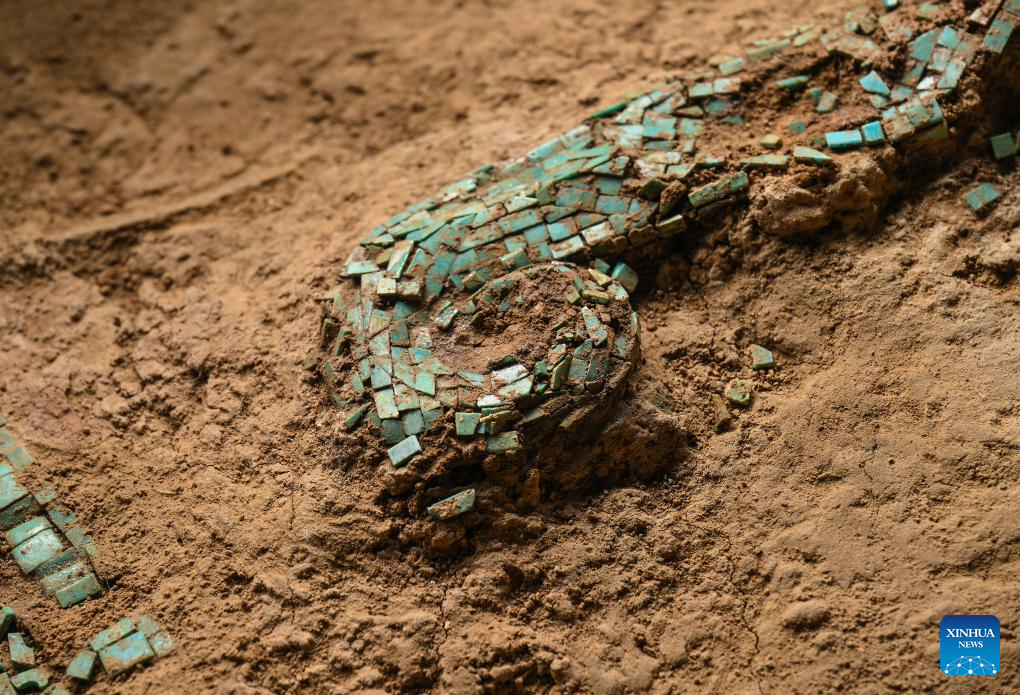
This photo taken on Jan. 29, 2024 shows the detail of the tail a turquoise dragon-form artifact at Chinese Archaeological Museum in Beijing, capital of China. Unearthed from Erlitou site in the city of Luoyang, the turquoise dragon-form artifact has a total length over 70 centimeters and was formed from more than 2,000 pieces of turquoise. Chinese archaeologists dubbed the artifact the "Dragon of China", which has great historical, artistic and scientific value. (Xinhua/Cai Yang)

This photo taken on Jan. 29, 2024 shows the detail of the head of a turquoise dragon-form artifact at Chinese Archaeological Museum in Beijing, capital of China. Unearthed from Erlitou site in the city of Luoyang, the turquoise dragon-form artifact has a total length over 70 centimeters and was formed from more than 2,000 pieces of turquoise. Chinese archaeologists dubbed the artifact the "Dragon of China", which has great historical, artistic and scientific value. (Xinhua/Li He)

This photo taken on Jan. 29, 2024 shows the detail of the tail of a turquoise dragon-form artifact at Chinese Archaeological Museum in Beijing, capital of China. Unearthed from Erlitou site in the city of Luoyang, the turquoise dragon-form artifact has a total length over 70 centimeters and was formed from more than 2,000 pieces of turquoise. Chinese archaeologists dubbed the artifact the "Dragon of China", which has great historical, artistic and scientific value. (Xinhua/Cai Yang)

This undated file photo shows an archaeologist working on a turquoise dragon-form artifact at Institute of Archaeology under the Chinese Academy of Social Sciences (IA CASS) in Beijing, capital of China. Unearthed from Erlitou site in the city of Luoyang, the turquoise dragon-form artifact has a total length over 70 centimeters and was formed from more than 2,000 pieces of turquoise. Chinese archaeologists dubbed the artifact the "Dragon of China", which has great historical, artistic and scientific value. (IA CASS/Handout via Xinhua)
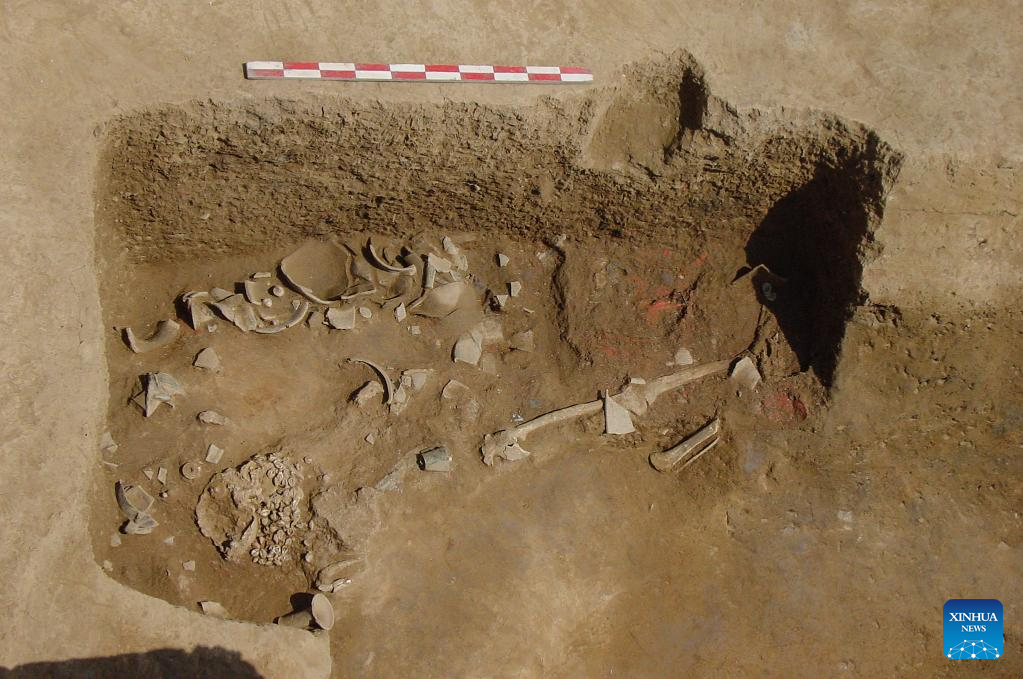
This undated file photo shows the excavation site of a turquoise dragon-form artifact at Erlitou site in Luoyang, central China's Henan Province. Unearthed from Erlitou site in the city of Luoyang, the turquoise dragon-form artifact has a total length over 70 centimeters and was formed from more than 2,000 pieces of turquoise. Chinese archaeologists dubbed the artifact the "Dragon of China", which has great historical, artistic and scientific value. (IA CASS/Handout via Xinhua)
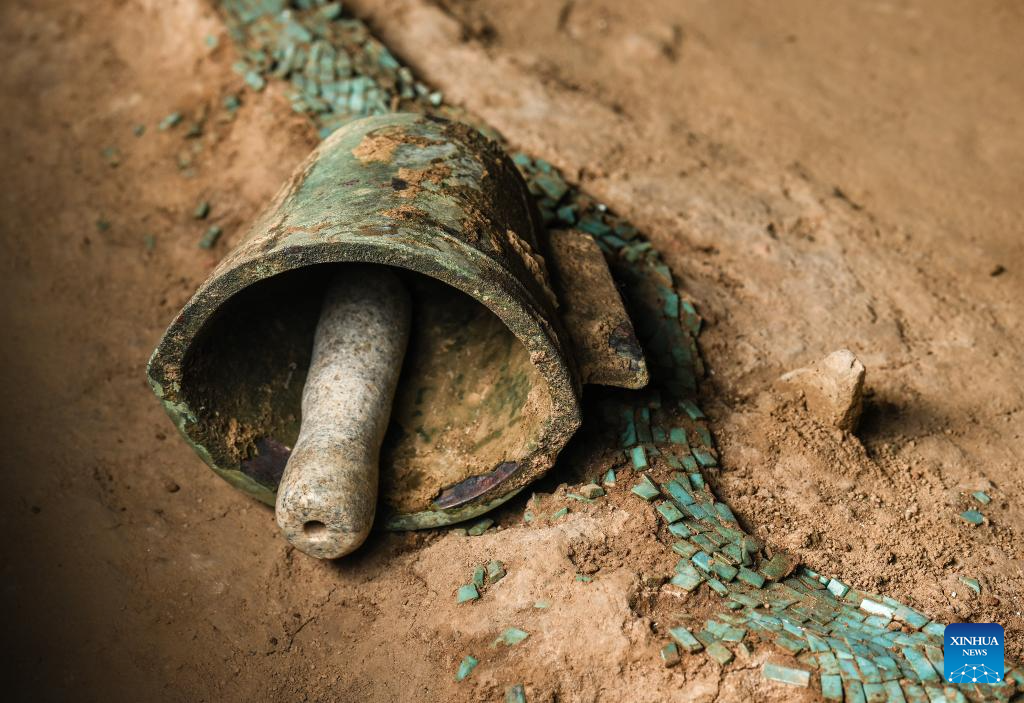
This photo taken on Jan. 29, 2024 shows a bell on a turquoise dragon-form artifact at Chinese Archaeological Museum in Beijing, capital of China. Unearthed from Erlitou site in the city of Luoyang, the turquoise dragon-form artifact has a total length over 70 centimeters and was formed from more than 2,000 pieces of turquoise. Chinese archaeologists dubbed the artifact the "Dragon of China", which has great historical, artistic and scientific value. (Xinhua/Han Fang)

This photo taken on Jan. 29, 2024 shows a bell on a turquoise dragon-form artifact at Chinese Archaeological Museum in Beijing, capital of China. Unearthed from Erlitou site in the city of Luoyang, the turquoise dragon-form artifact has a total length over 70 centimeters and was formed from more than 2,000 pieces of turquoise. Chinese archaeologists dubbed the artifact the "Dragon of China", which has great historical, artistic and scientific value. (Xinhua/Han Fang)

This photo taken on Jan. 29, 2024 shows part of a turquoise dragon-form artifact at Chinese Archaeological Museum in Beijing, capital of China. Unearthed from Erlitou site in the city of Luoyang, the turquoise dragon-form artifact has a total length over 70 centimeters and was formed from more than 2,000 pieces of turquoise. Chinese archaeologists dubbed the artifact the "Dragon of China", which has great historical, artistic and scientific value. (Xinhua/Li He)

This photo taken on Jan. 29, 2024 shows the detail of the head of a turquoise dragon-form artifact at Chinese Archaeological Museum in Beijing, capital of China. Unearthed from Erlitou site in the city of Luoyang, the turquoise dragon-form artifact has a total length over 70 centimeters and was formed from more than 2,000 pieces of turquoise. Chinese archaeologists dubbed the artifact the "Dragon of China", which has great historical, artistic and scientific value. (Xinhua/Han Fang)

This photo taken on Jan. 29, 2024 shows part of a turquoise dragon-form artifact at Chinese Archaeological Museum in Beijing, capital of China. Unearthed from Erlitou site in the city of Luoyang, the turquoise dragon-form artifact has a total length over 70 centimeters and was formed from more than 2,000 pieces of turquoise. Chinese archaeologists dubbed the artifact the "Dragon of China", which has great historical, artistic and scientific value. (Xinhua/Li He)

An aerial drone photo taken on Oct. 16, 2019 shows the Erlitou archaeology park in Luoyang, central China's Henan Province. Unearthed from Erlitou site in the city of Luoyang, the turquoise dragon-form artifact has a total length over 70 centimeters and was formed from more than 2,000 pieces of turquoise. Chinese archaeologists dubbed the artifact the "Dragon of China", which has great historical, artistic and scientific value. (Xinhua/Li An)

This photo taken on Jan. 29, 2024 shows the details of a turquoise dragon-form artifact at Chinese Archaeological Museum in Beijing, capital of China. Unearthed from Erlitou site in the city of Luoyang, the turquoise dragon-form artifact has a total length over 70 centimeters and was formed from more than 2,000 pieces of turquoise. Chinese archaeologists dubbed the artifact the "Dragon of China", which has great historical, artistic and scientific value. (Xinhua/Li He)

This photo taken on Jan. 29, 2024 shows a turquoise dragon-form artifact at Chinese Archaeological Museum in Beijing, capital of China. Unearthed from Erlitou site in the city of Luoyang, the turquoise dragon-form artifact has a total length over 70 centimeters and was formed from more than 2,000 pieces of turquoise. Chinese archaeologists dubbed the artifact the "Dragon of China", which has great historical, artistic and scientific value. (Xinhua/Li He)

This photo taken on Jan. 29, 2024 shows the details of a turquoise dragon-form artifact at Chinese Archaeological Museum in Beijing, capital of China. Unearthed from Erlitou site in the city of Luoyang, the turquoise dragon-form artifact has a total length over 70 centimeters and was formed from more than 2,000 pieces of turquoise. Chinese archaeologists dubbed the artifact the "Dragon of China", which has great historical, artistic and scientific value. (Xinhua/Li He)

This undated file photo shows archaeologists working on a turquoise dragon-form artifact at Institute of Archaeology under the Chinese Academy of Social Sciences (IA CASS) in Beijing, capital of China. Unearthed from Erlitou site in the city of Luoyang, the turquoise dragon-form artifact has a total length over 70 centimeters and was formed from more than 2,000 pieces of turquoise. Chinese archaeologists dubbed the artifact the "Dragon of China", which has great historical, artistic and scientific value. (IA CASS/Handout via Xinhua)
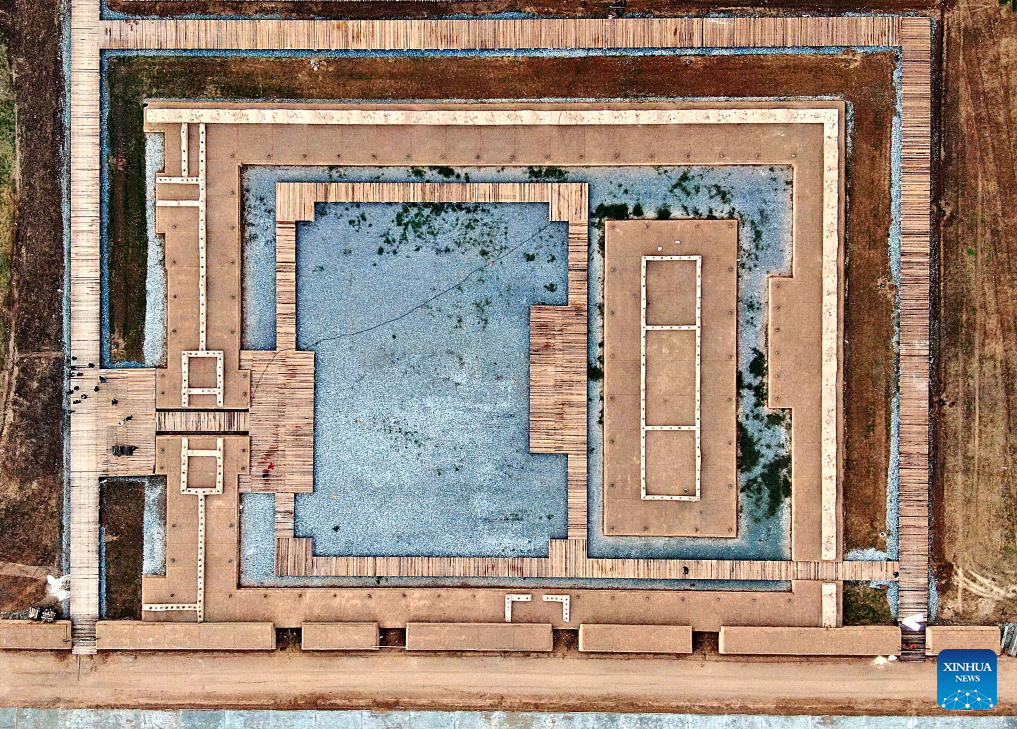
An aerial drone photo taken on Oct. 16, 2019 shows the Erlitou archaeology park in Luoyang, central China's Henan Province. Unearthed from Erlitou site in the city of Luoyang, the turquoise dragon-form artifact has a total length over 70 centimeters and was formed from more than 2,000 pieces of turquoise. Chinese archaeologists dubbed the artifact the "Dragon of China", which has great historical, artistic and scientific value. (Xinhua/Li An)

This undated file photo shows the excavation of a turquoise dragon-form artifact at Erlitou site in Luoyang, central China's Henan Province. Unearthed from Erlitou site in the city of Luoyang, the turquoise dragon-form artifact has a total length over 70 centimeters and was formed from more than 2,000 pieces of turquoise. Chinese archaeologists dubbed the artifact the "Dragon of China", which has great historical, artistic and scientific value. (IA CASS/Handout via Xinhua)



